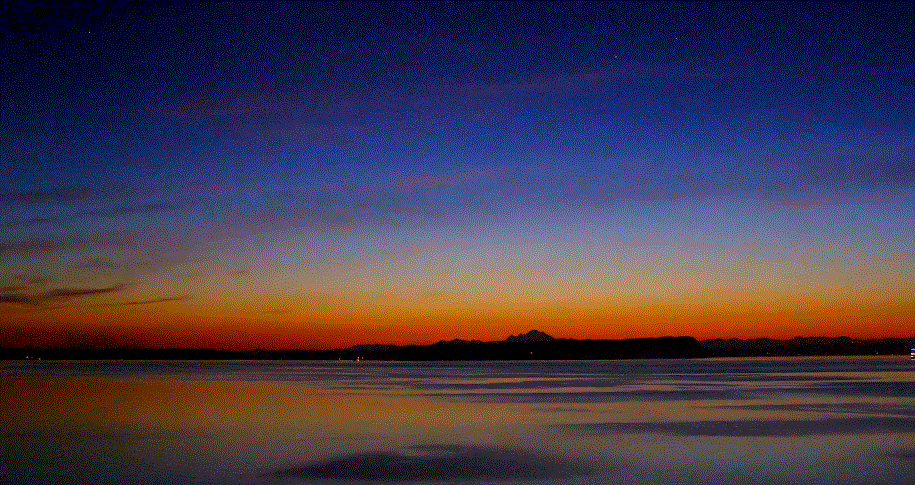The official sunset and sunrise are 9:11 PM and 5:12 AM, respectively, for 15 hours, 59 minutes, and 20 seconds of daylight. But that does not even start to tell the story because light lingers in the sky for hours after dusk and before dawn--as you will experience in a few minutes.
Another definition of the beginning and ending of night is civil twilight. Before that time after sunset, under good weather conditions, there is enough light for objects to be clearly distinguished without extra illumination. The same is true between civil twilight and sunrise in the morning. Technically, civil twilight occurs when the sun is below the horizon by 6 degrees.
The past two days, civil twilight times were 9:52 PM and 4:31 AM. So there is about 40 minutes on both sides of sunrise and sunset during which you could see what your are doing outside. Here is an example of the view between sunrise and civil twilight
4:57 AM on June 22, looking north from the Kitsap Peninsula (courtesy of Greg Johnson)
And then there is nautical twilight, until which time the general outlines of objects can be distinguished and the horizon is still visible even on a moonless night. Technically, the sun is 12 degrees below the horizon at nautical twilight. The last few days nautical twilight was at 10:48 PM and 3:34 AM, roughly adding 1 hour 40 minutes to the "day" at both ends. Night is getting mighty short. Here is an example of the view during the period between civil and nautical twilight:
3:57 AM on June 22nd (picture courtesy of Greg Johnson)
And finally, there is astronomical twilight. At night, after astronomical twilight there is less scattered light from the sun than from starlight or natural sources. Dark enough for our astronomer friends to work. Technically, the sun is at 18 degrees below the horizon at astronomical twilight. During the past few days, astronomical twilight times have been 12:19 and 2:03 AM. So as far as astronomers are concerned there is less than two hours of night around here near the solstice. You have to feel sorry for them. They have to work fast! And if you go just a bit further north--like Bellingham--there is NO astronomical twilight. It never gets completely dark there by this definition.
And now it is time for a real treat. Local cam maestro Greg Johnson runs high resolution cams from his home on the Skunk Bay of north Kitsap and below you can view his animations as the sky got dark and then lit up for the last two nights. Just amazing. There is perceptible light in the sky until around 11:20 PM and brightening begins about 2:50 AM. (you can stop and start the videos if you like). We are talking only 3.5 hours of night from a visual perspective. No wonder the birds start to sing before 4 AM, their visual alarm clock is ringing by then.
Here is the animation for June 21st.
Night Video Of Summer Solstice 2014 from SkunkBayWeather on Vimeo.
And on June 22nd, there were less clouds, so the light in the sky was even more evident.
Night Video of 6/21 into 6/22 from SkunkBayWeather on Vimeo.
Enjoy....





This is a delightfully informative article, thank you Professor!
ReplyDeletethough it makes this unworthy one wonder where Jean Meeus et.al get their renown -0.83, or sometimes 16 arc minutes, for rising and setting. half the diameter of the solar disc perhaps, or not.
comic linke in thanks:Seems like we get the 'storm of the century' more often than we used to
You'll get what's known as "white nights" north of 60°33’. Those are days during which the sky never gets beyond civil twilight.
ReplyDeleteNorth of 54°33’ (north of Germany, most of England, Kazakhstan, and midway up the southern Canadian provinces), you'll at least get nights in which the sky never gets beyond nautical twilight. (At least some light will remain in the northern portion of the sky.) This is ideal to me: you can still follow the sun without struggling to fall asleep from lack of darkness. (Though granted, night won't last long.)